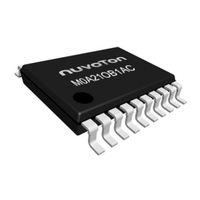Nuvoton NuMicro M0A23OC1AC Manuals
Manuals and User Guides for Nuvoton NuMicro M0A23OC1AC. We have 1 Nuvoton NuMicro M0A23OC1AC manual available for free PDF download: Technical Reference Manual
Nuvoton NuMicro M0A23OC1AC Technical Reference Manual (746 pages)
Arm Cortex -M0-based Microcontroller
Brand: Nuvoton
|
Category: Microcontrollers
|
Size: 9 MB
Table of Contents
-
Features18
-
Package Type26
-
System Manager101
-
Overview101
-
System Reset101
-
Chip Bus Matrix114
-
IRC Auto Trim114
-
Register Map116
-
Clock Controller182
-
Overview182
-
Clock Generator183
-
Clock Output187
-
Register Map188
-
Overview208
-
Features208
-
Block Diagram208
-
Register Map227
-
Overview237
-
Features237
-
Block Diagram238
-
Register Map243
-
Overview259
-
Features259
-
Block Diagram259
-
Register Map266
-
Overview294
-
Features294
-
Block Diagram295
-
Register Map304
-
Overview317
-
Features317
-
Block Diagram317
-
Register Map321
-
Overview326
-
Features326
-
Block Diagram326
-
Register Map331
-
Overview337
-
Features337
-
Block Diagram338
-
Register Map365
-
Overview416
-
Features416
-
Block Diagram417
-
Register Map446
-
Overview485
-
Features485
-
Block Diagram485
-
USCI - UART Mode496
-
Overview496
-
Features496
-
Block Diagram496
-
Register Map507
-
USCI - SPI Mode529
-
Overview529
-
Features529
-
Block Diagram530
-
Register Map543
-
Overview567
-
Features567
-
Block Diagram568
-
Register Map587
-
Overview607
-
Features607
-
Block Diagram607
-
Test Mode610
-
Register Map628
-
Overview667
-
Features667
-
Block Diagram667
-
Register Map670
-
Overview676
-
Features676
-
Register Map677
-
Overview683
-
Features683
-
Block Diagram684
-
Register Map692
-
Overview708
-
Features708
-
Block Diagram708
-
Register Map713
-
Overview721
-
Features721
-
Block Diagram721
-
Register Map728
-
Overview736
-
Abbreviations743
Advertisement
